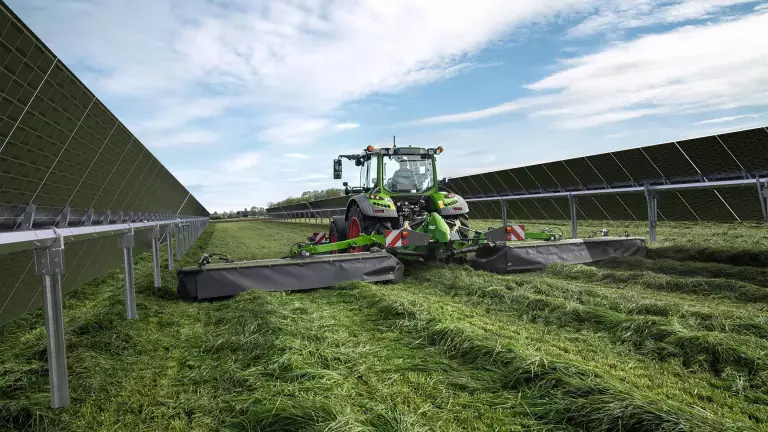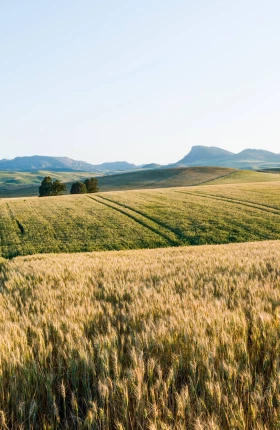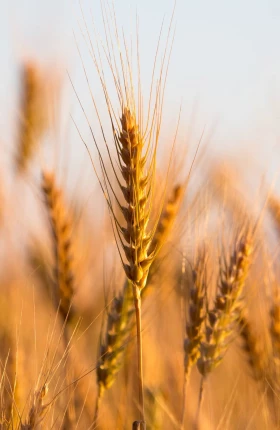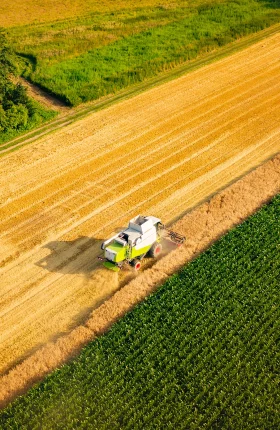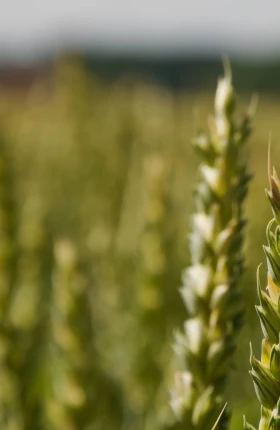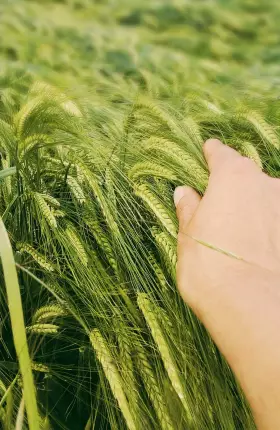Regenerative agriculture (RegenAg) is an adaptive farming approach designed to improve soil health, enhance biodiversity, and increase climate resilience. It can provide a triple win: long-term economic benefits for farmers, more resilient and sustainable food production, and a positive environmental impact.
Despite the compelling advantages of RegenAg, farmers often face hurdles during the transition phase due to set up costs and reductions in agricultural yields, which can result in a profitability dip.
Photovoltaics (PV) can play a key role in helping farmers through this phase.
Our report explores the use of Agri-PV. A method for integrating solar power generation with farming, Agri-PV is uniquely effective because it enables the production of agricultural goods and renewable energy from the same plot of land.
To explore the true impact of Agri-PV, we conducted a study in Germany based on models of three farm archetypes – small, medium, and large.
We found that long term, anticipated additional profits are significant:
- Small Farm Archetype: €15,000–€17,000 a year.
- Medium Farm Archetype: €55,000–€75,000 a year.
- Large Farm Archetype: €175,000–€235,000 a year.
Although first year gains are somewhat lower, the farms receive an additional income boost from the start, helping them to bridge the profitability gap while transitioning from conventional farming to RegenAg.
Our analysis shows that Agri-PV helps to stabilize the income for all three farm archetypes during this period.
Whether they have small, medium or large farms, we encourage farmers to explore the potential of Agri-PV.
Recap RegenAg: A Triple-Win with Required Transition Phase
Regenerative agriculture (RegenAg) is an adaptive farming approach designed to improve soil health, enhance biodiversity, and increase climate resilience. It moves beyond traditional farming methods by prioritizing soil regeneration, minimal land disturbance, and biodiversity promotion through practices including no-till farming, permanent soil coverage, and crop rotation. By focusing on the health of the soil and ecosystems, RegenAg creates more resilient farms that can better withstand extreme weather and adapt to climate change.
For farmers, RegenAg offers significant long-term economic benefits by delivering larger and more stable profits. This increase comes from the reduced cost of inputs such as fertilizer, lower operational expenses for fuel and labor, more stable yields due to healthier soils, and improved resilience against droughts and floods.
Furthermore, RegenAg practices contribute to a more resilient food supply, especially in dry years, and a reduction in greenhouse gas emissions. Additionally, they improve water use efficiency and promote biodiversity, benefiting the agricultural sector, the environment and broader society.
To sum it up, RegenAg provides a triple win: higher profits for farmers, more resilient and sustainable food production, and a positive environmental impact.
However, these wins are not immediate. Despite the compelling long-term advantages of RegenAg, farmers often face hurdles during the transition phase. Making the switch requires investment in equipment, such as direct seeding machinery, and in learning and support from agronomic advisers, when needed. Along with the possibility of temporary yield reductions as the farmer adapts to the new system, this can create an actual or perceived profitability gap in the early years of adoption. Typically, higher profits are only realized around six to ten years after starting the transition.
Photovoltaics (PV) can play a key role in helping farmers bridge this gap. By generating energy that can be consumed for their own needs or sold on the market, solar power provides farmers with financial stability during this challenging time of transition, while supporting the broader goal of moving towards a more sustainable way of living.
What is Agri-PV?
Many PV applications are suitable for farms, including panels that can be installed on stable and shed rooftops, larger scale arrays that can be mounted on former agricultural land, and “nature-inclusive PV” concepts that aim to enhance biodiversity on set-aside agricultural areas.
However, this report focuses on Agri-PV. A method for integrating solar power generation with farming, Agri-PV is uniquely effective because it enables the production of agricultural goods and renewable energy from the same plot of land.
Agri-PV systems come in various forms that are adapted for different configurations and types of farming systems (see exhibit 1). They can be installed on both grassland (Cow-PV) and arable land (Crop-PV).
Two primary configurations of Agri-PV systems are common in Europe:
- Elevated Systems: Solar panels are installed overhead, allowing agricultural activities such as crop production or livestock grazing to occur underneath.
- Inter-row systems: Solar panels are arranged as fixed vertical modules in rows. Agricultural activities, such as crop production or livestock grazing, take place in between the rows.
There are three main types of Inter-row Systems:
- Fixed Vertical Systems: Solar panels are installed vertically in rows in an east/west orientation allowing good energy yield during the morning and afternoon hours, but lower energy yield around midday.
- Fixed Tilt Systems. Solar panels are mounted on a fixed structure, usually at a set angle in southward orientation. These system types are simpler and have fewer moving parts but might not capture solar energy as efficiently as tracking systems.
- Tracking Systems. These systems use motorized PV module tables that follow the movement of the sun across the sky, maximizing energy production throughout the day. The most common in the industry are Horizontal Single-Axis Trackers. The PV-rows are installed in a north/south orientation, allowing the panels to move from east to west during sunrise to sunset. Tracking systems are more expensive than fixed-tilt systems but provide better agronomical yields and generate more solar power.
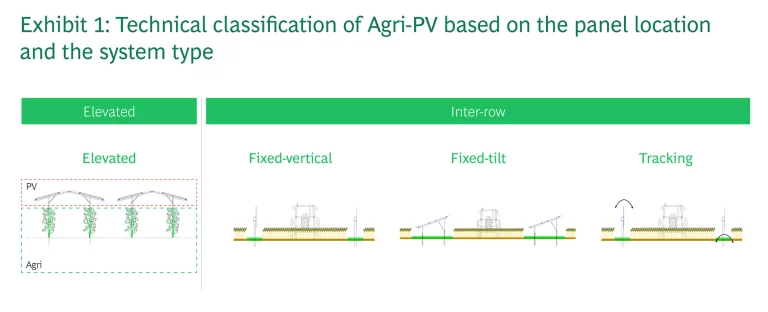
Exhibit 1: Technical classification of Agri-PV based on the panel location (top) and the system type (bottom)
What’s in it for Farmers: Increasing Land Use Efficiency, Economic Performance and Income Diversification
Agri-PV can offer farmers an attractive combination of greater land use efficiency and financial stability. By producing agricultural goods and energy from the same plot of land, it can help farmers diversify revenue streams and reduce financial risk. Additionally, the system’s dual functionality maintains the agricultural status of the land, allowing farmers to qualify for subsidies and tax benefits.
Impact of Agri-PV systems on agricultural land and yields
Agri-PV systems typically cause agricultural yields to drop by 10%-15%, depending on the local conditions, which crops or livestock are being farmed, and the configuration of the system.
Additionally, by placing the systems within cropland or grassland, the amount of productive land is reduced (see exhibit 2). Agri-PV usually has less impact on permanent pastureland because grass is relatively shade-tolerant and livestock can graze below and around the modules. Cropland and grassland used for hay production lose a greater productive area because agricultural machines (for example, harvesters) cannot get close to the modules, and risk damaging them if they do. Zones below and next to panels cannot be used for planting (zone 1) and the shade created by panels can reduce yields in adjacent zones (zone 2). Therefore, our assumption is that productive land is reduced by 1%-5% on permanent pastureland and 12%-15% on cropland and grassland used for hay production.
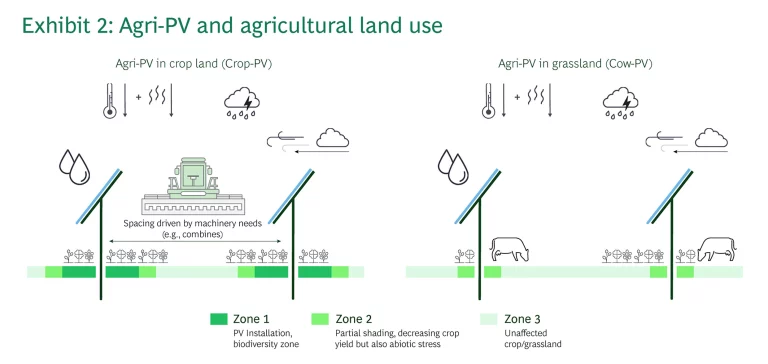
Exhibit 2: Agri-PV and agricultural land use
Selling and consuming energy
Farmers who adopt Agri-PV systems can gain a reliable revenue stream and consistent source of income, usually based on self consumption, short-term feed-in tariffs or long-term contracts with guaranteed prices (PPAs).
In many cases the produced energy is – at least partially – used by the farmer. This can benefit farms that operate energy-intense structures and processes such as grain-drying, cold storage, electrical irrigation systems, or greenhouses with horticulture lighting systems. Even with the overheads, self-produced electricity is typically cheaper than electricity supplied through the grid. In such cases only the excess energy that is not used directly on-farm is sold and fed into the grid.
The excess energy can be monetized either through short-term feed-in tariffs or PPAs. In an on-site PPA, power is sold direct to a nearby commercial or industrial customer, and what remains is fed into the grid. In an off-site PPA, the power is fed into the grid, but guarantees of origin are accredited to a purchasing party, which enables the purchaser to achieve a cleaner energy mix.
If the farmer owns the land and leases it to a PV project developer and operator, an additional service agreement can generate supplementary income if the farmer provides services such as greenkeeping and module cleaning for the Agri-PV equipment.
A detailed overview of different Agri-PV business model schemes is provided by the Agrisolar Handbook published by SolarPowerEurope in November 2024.
Beyond Pure Profit: Enhancing Biodiversity, Soil Health, and Climate Resilience
In addition to their positive financial impact, Agri-PV systems offer numerous ecological and climate-related benefits (see exhibit 3):
- Shade provision: Solar panels cast shadows, benefiting both crops and livestock. This helps to lower temperatures on the ground and decrease water consumption. Extra shade can also improve crop yields and animal performance by reducing stress during severe weather events such as droughts and extreme heat.
- Wind protection: Solar panels can act as windbreaks, reducing damage to crops and soil erosion, stabilizing soil temperatures, and creating a more stable and thus favorable microclimate for plants and animals.
- Increased biodiversity: A variety of flowers, herbs and other vegetation flourish on the non-arable strips directly under the Agri-PV systems, attracting beneficial insects like bees and beetles, along with other animal species. This contributes to a diverse and balanced ecosystem and improves biodiversity below ground.
- Soil regeneration: The extra shade and wind protection reduces water loss and can improve water infiltration and retention, which is crucial for maintaining healthy soils. This enhanced moisture level supports soil fertility, contributing to crop growth and the long-term health of the land.
Agri-PV installations improve land use efficiency, enhance biodiversity, and protect agricultural operations against climate risks. By integrating solar energy generation and agricultural activities, farmers can secure a diversified income stream, reduce financial risk, increase the sustainability of their farms, and contribute to the broader goal of safeguarding the natural environment. Although Agri-PV projects typically occupy a relatively small area of land, they can have a positive impact on the entire farm.
In conclusion, Agri-PV can offer farmers transitioning to RegenAg a holistic and highly synergistic solution. As the pressures of climate change intensify, Agri-PV represents a key opportunity for the agricultural sector to adapt and thrive.
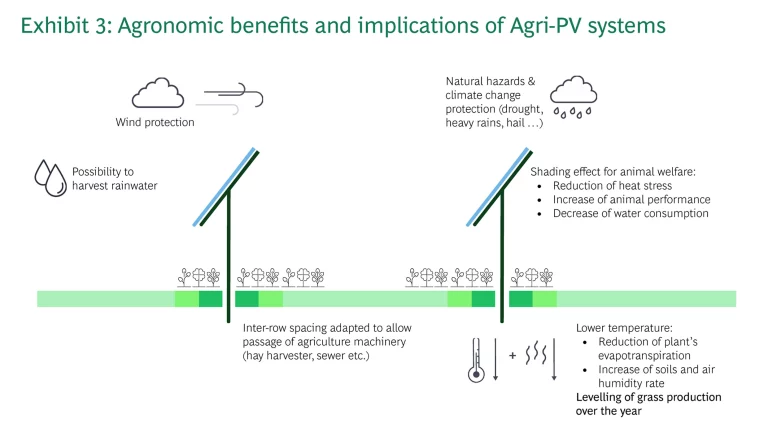
Exhibit 3: Agronomic benefits and implications of Agri-PV systems
Subscribe to our Industrial Goods E-Alert.
Down to the Financials: German Farm Archetypes and PV Schemes
Farmers’ experiences of Agri-PV depend on the type of farm they run, its size, the choice of PV system, the location of the land and annual sunshine intensity.
To capture these nuances, we conducted a study in Germany, which leads on from our prior study on RegenAg. Analyzing the experience of farmers in Germany, which has well-developed agricultural markets, reveals the challenges and benefits of implementing Agri-PV that apply throughout Europe, and beyond.
We created models for three farm archetypes – small, medium, and large – and assessed the impact of Agri-PV systems on farmers’ finances as they make the transition to RegenAg (see exhibit 4).
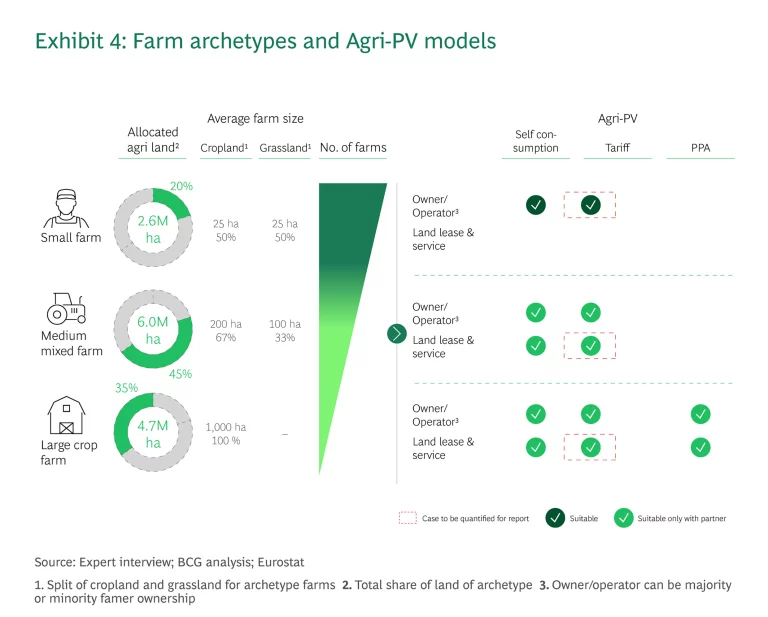
Exhibit 4: Farm archetypes and Agri-PV models
Small Farm Archetype
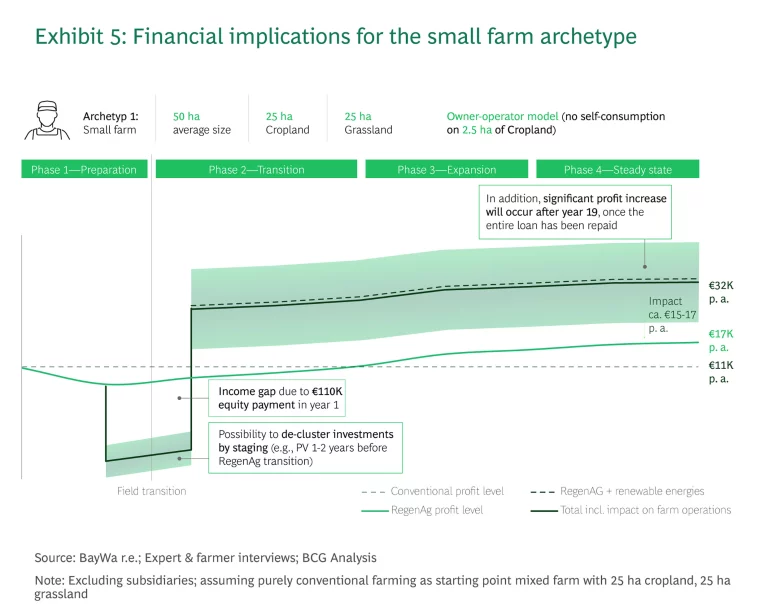
Exhibit 5: Financial implications for the small farm archetype
The archetype small farm averages 50 hectares, with an equal split between cropland and grassland. In our model, the farm operates the Cow-PV system (see chapter 2) on pastureland. It is assumed that 5% of the land, amounting to
Additionally, most of that land remains productive, because the livestock can graze beneath the solar panels, so only 1%-5% of the project area is effectively “lost.” Furthermore, the PV modules provide shade from the sun and shelter from rain and hail, improving animal welfare.
In this model, farmers purchase the Agri-PV system from a local installer using a bank loan. This is typical for small farms as most renewable project developers only offer land lease models for larger projects.
The capital expenditure for a small farm’s Agri-PV system is approximately €1.1 million, including grid connection, with the farmer contributing 10% as equity and financing the remainder through a loan. Loan repayment, along with operational expenditures, amounts to roughly €95,000 a year.
An Agri-PV system of this size produces approximately 1.2 million kWh of electricity per year, generating an annual revenue of around
The owner-operator model offers flexibility in terms of energy use. In this model, all the power produced is sold to the grid for an agreed tariff. However, to further increase the financial benefits, some of the power produced by the Agri-PV system could be consumed on the farm.
The profitability of the Agri-PV project helps small farms manage the costs of transitioning to RegenAg, and provides long-term financial benefits. Installing the Agri-PV system before starting the transition can help to avoid simultaneous dips in income.
Medium Farm Archetype
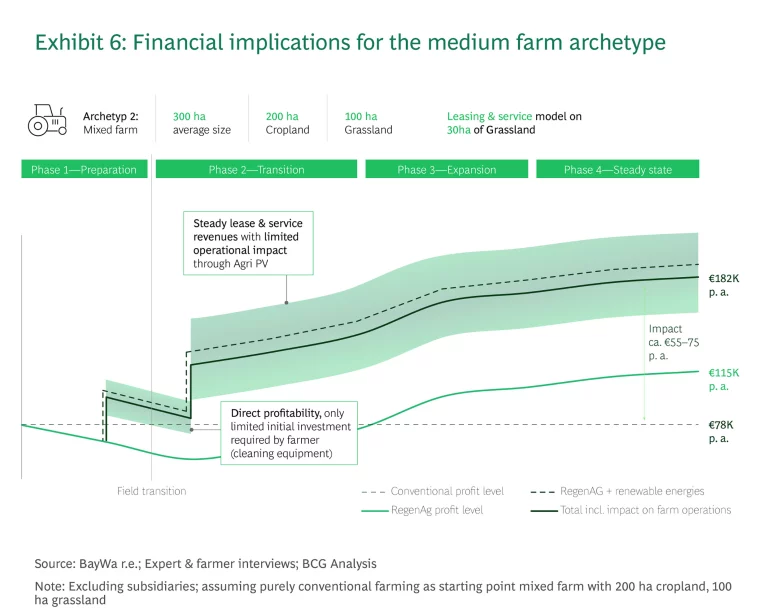
Exhibit 6: Financial implications for the medium farm archetype
Our model is a 300-hectare farm, with 200 hectares of cropland and 100 hectares of grassland. It assumes that 10% of the land – 30 hectares – is allocated for the Agri-PV project.
For medium farms, we assumed that Agri-PV systems are implemented through a land lease and service model, typically on grassland. In this model, the farmer leases the land to a solar developer. This reduces the need for large upfront investments while offering a reliable source of income to farmers.
Annual payments of €1,800–€2,200 per hectare are typical, with an additional €500 per hectare for greenkeeping within the project area and PV module cleaning.
However, the farm’s productive area is reduced and assuming the farmer is implementing a Cow-PV system on grassland, which is used for both hay production and as pasture, around 8%-12% of the project area will become unusable. The farmer will also see yields dip by 10%–15%, as it typical for Agri-PV projects. They will receive up to 15% less in subsidies, and will incur costs including the purchase of cleaning equipment, which requires an outlay of approximately €40,000 in the first year, and ongoing maintenance (such as mowing and wet-cleaning the PV modules), which costs €200–€400 per hectare.
On balance though, the benefits are significant. Medium farms can expect a profit of around €20,000–€30,000 in the first year and after that, annual profits of €55,000–€75,000. The income from leasing and service provision is especially valuable during the transition to RegenAg, helping to compensate for revenue that may be lost during the early stages of transformation. Farmers can choose to install the Agri-PV system one year early to spread costs, but this is not usually necessary given the system’s profitability.
Large Farm Archetype
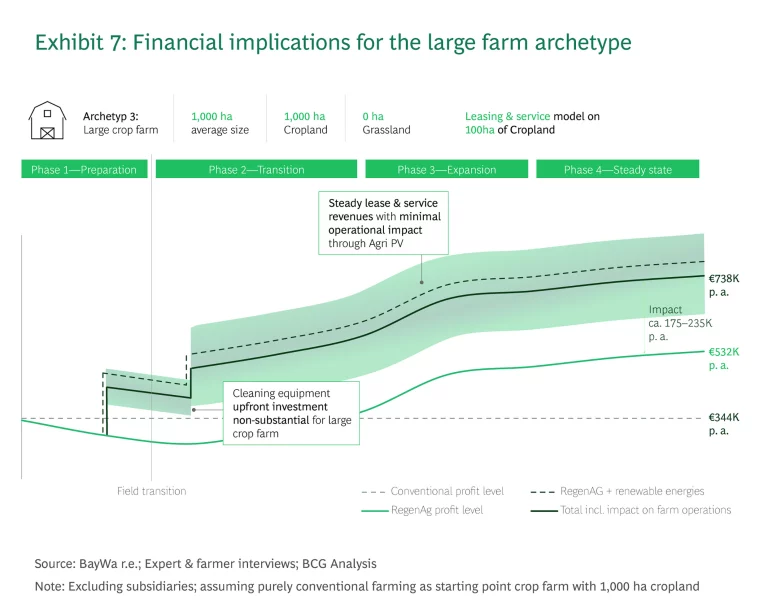
Exhibit 7: Financial implications for the large farm archetype
Occupying 1,000 hectares, the large farm consists entirely of cropland with 10% of the area – 100 hectares – dedicated to the Agri-PV installation. This archetype also operates a land lease and service model, with similar lease payments to medium farms.
Large crop farms can gain substantial profits from Agri-PV. According to our model, incremental profits range from €140,000–€190,000 in the first year, and increase to €175,000–€235,000 in subsequent years.
More revenue is lost per hectare compared to the small and medium farm model, because the system is installed on cropland instead of grassland. The farmer can expect to lose 10%–15% in yield and 12%–15% of the cropland. However, this can be allocated to biodiversity, with green strips located beneath the PV panels. Additionally, reduced subsidies up to 15% and servicing costs apply. Despite these losses, the system has significant financial benefits for farmers implementing RegenAg practices from the first year of transition onwards, avoiding a profitability dip.
Large crop farms can also explore auction schemes in the special segment within the Renewable Energy Act
Nature-inclusive PV and wind energy
Farms that opt for nature-inclusive PV do not incur extra expenses and can achieve an overall profit of roughly €2,000–€3,000 per hectare per year. Ideally, if the system is implemented on voluntarily set-aside cropland area, farmland status is
Some farmers install wind energy projects, rather than PV options. The wind turbines and associated infrastructure, such as access roads, occupy a relatively small amount of land, but command much higher land lease fees than Agri-PV and nature-inclusive PV projects. A downside is that onshore wind projects take much longer to develop than PV and Agri-PV projects. However, if well planned and executed, wind projects can bring benefits at the community level by enabling multiple farms to transition at the same time. A best practice example for wind projects, implemented by BayWa r.e. in France to promote the RegenAg transition, has brought eight farmers additional income
Considerations When Implementing Agri PV
Agri-PV is as an interesting and attractive option for small, medium and large farms transitioning to RegenAg. By offering both short-term financial relief and long-term profitability, Agri-PV enables farmers to navigate the challenges of transitioning to regenerative farming, while ensuring a stable income stream. Whether through ownership or land leasing, Agri-PV provides flexibility and resilience, positioning farms for a future that’s better for them and better for the planet.
We have used simplified models of single farms for this report but in the real world, solar power generation and related proceeds can bring benefits for farming co-operatives and rural communities that devise co-ownership models. In many cases they may use the electricity too. In this way, Agri PV can act as a stimulus for rural value creation beyond the perimeter of the farm and the scope of RegenAg.
Although Agri-PV presents valuable opportunities, it is not without risks. Operational risks such as damage to PV modules can increase costs, long-term lease agreements introduce contractual risks, and PV systems may underperform. Regulatory changes, extreme weather events, and the financial stability of project developers also introduce uncertainties that farmers should consider when adopting Agri-PV.
Who is Agri-PV Best Suited for?
Agri-PV is generally suited for farms with pastureland, grassland for hay production or those growing crops. Medium to large farms, especially those in regions with plentiful sunshine, are well-suited for Agri-PV, as they can balance energy generation and agricultural productivity without compromising yields or livestock welfare. Smaller farms can also benefit, particularly through customized solar configurations that fit their needs.
For successful Agri-PV implementation, farms must comply with local and national regulations. It’s crucial that agricultural activities remain the primary use, with solar energy as a complementary function. Farmers should consult with authorities to ensure their plans meet zoning laws and agricultural standards, which allow them to benefit from subsidies and tax advantages. Aligning with these legal frameworks ensures long-term project viability. In some European nations there are programs that support the implementation of Agri-PV. In Germany, for example, the “Rentenbank” offers low-cost financing to small farms, as do federal state development
A Structured Process for Agri-PV: The 7 C’s
To implement Agri-PV successfully, it is important to follow a structured process that covers seven key steps – known as the 7 C’s. These steps ensure that both the agricultural and energy aspects of the system are optimized for the farm’s needs. Ideally, they will be carried out by the farmer in partnership with an Agri-PV project developer.
Conditions:
Begin by analyzing the specific agronomical conditions of the farm – soil type, crop selection, and local climate, especially sunshine intensity. This information will guide the design and setup of the Agri-PV system.
Comprehensive farm view:
Evaluate the financial impact and estimate future income streams, considering projected agricultural production, the costs of Agri-PV, and the potential income from selling energy. Also consider possible investments, such as agricultural equipment, implications for subsidies, and decide whether the owner-operator model or lease model is the best option. Assess which of the farm’s fields and meadows are best suited for Agri-PV installation.
Configuration:
Define the technical specifications of the system, such as the layout of the panels, their tilt, and distances from key farm structures, ensuring they integrate seamlessly with agricultural activities.
Crop and Animal Performance:
Conduct a pre-analysis to predict how the system will affect crop yields, light availability, and livestock welfare at the selected location. This step ensures that the Agri-PV system will enhance, rather than hinder, agricultural productivity.
Consumption:
Assess the proportion of energy that will be used on the farm versus the amount transferred to the grid and develop the business case. This balance is key to ensuring the system’s financial viability. Depending on tariffs, significant cost savings can be made by consuming power generated by the farm rather than purchasing it from the grid.
Compatibility:
Make sure that the project complies with all legal requirements and aligns with the country’s agricultural standards as well as tax legislation. This helps secure subsidies and ensures the system remains viable.
Collaboration:
Engage with stakeholders such as local authorities, research centers, and maintenance teams to leverage their expertise and ensure the project runs smoothly. All risks and benefits, and liabilities and obligations, must be agreed upon. The land lease agreement, the service agreement for greenkeeping of the project area, and/or the PPA are governed by signed contracts. The basis of a smooth permitting process is a holistic and transparent agricultural concept explaining how the Agri-PV system is integrated into the farm’s agricultural model, and what benefits it brings.
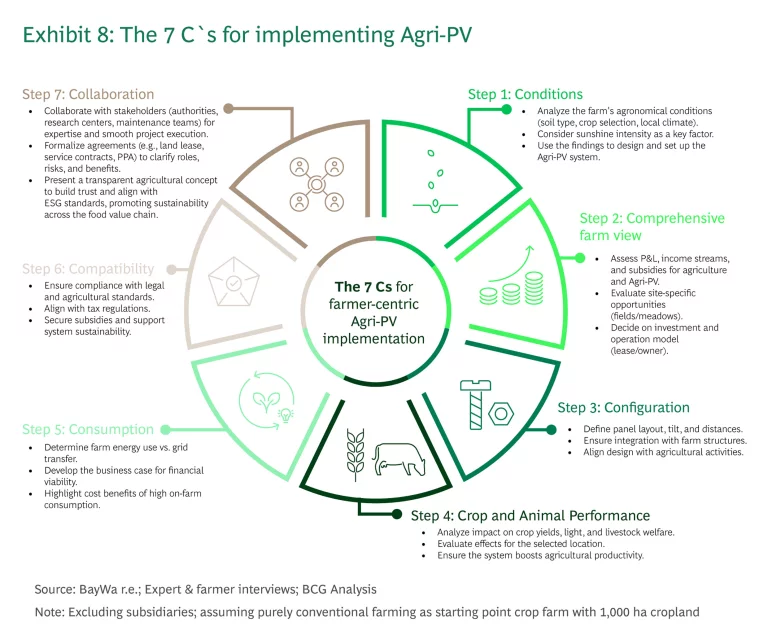
Exhibit 8: The 7 C`s for implementing Agri-PV
Conclusion: A Call to Action for Farmers Considering Agri-PV while transitioning to RegenAg
Agri-PV offers farmers an innovative way to boost and diversify income – an opportunity to improve their finances while contributing to environmental sustainability. It can also help to stabilize the farm’s income during the transition period from conventional to RegenAg. Whether they have small, medium or large farms, we encourage farmers to explore the potential of Agri-PV by following the structured approach described above. Careful analysis and leveraging the available support can help unlock their farm’s potential to become more profitable and sustainable.
Support from Regulators and Policy Makers
Agri-PV project implementation requires engagement with five policy areas: energy, agriculture, tax, environment, and building permits.
In Germany, a holistic policy regime offers support to the three different farm archetypes. However, at the EU level, many member states are yet to introduce coherent Agri-PV regulations that apply to different farming sectors.
To encourage widespread Agri-PV adoption, we recommend:
EU: To provide farmers with more certainty, the EU could consider establishing an Eco Scheme to support agricultural activity within Agri-PV projects as part of the second pillar within the EU CAP policy. This would send a clear message to member states that EU regulation encourages EU CAP payments to farmers who are adopting Agri-PV projects, and fosters support for this resource-efficient dual use of farmland.
Member States: Within their National Strategy Plans for Agriculture, EU Members States could allow Eco-PV project development on arable land that has been set aside to support biodiversity. A policy framework like this would mean less farmland was lost to the PV project, while encouraging sustainable practices and soil regeneration.
Regulators: To encourage widespread Agri-PV adoption on small farms, regulators could offer an equity payout scheme. A tax could be levied on large solar projects and redistributed to smaller farms to help them cover the cost of Agri-PV implementation. Alternatively, small farms could be encouraged to join forces and jointly engage in sizeable PV projects across the borders of their individual landholdings. Projects conducted via special entities such as Agri-PV cooperatives could be granted administrative advantages such as accelerated approval timelines and tax benefits.
Additionally, continued financial support, through subsidies and energy production tariffs, will play a vital role in helping farmers cover the initial costs of implementing Agri-PV.
